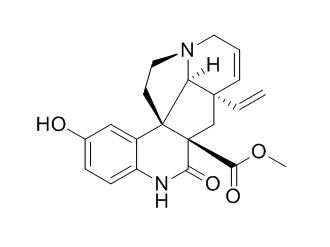10-Hydroxyscandine
Reference standards.
Inquire / Order:
manager@chemfaces.com
Technical Inquiries:
service@chemfaces.com
Tel:
+86-27-84237783
Fax:
+86-27-84254680
Address:
1 Building, No. 83, CheCheng Rd., Wuhan Economic and Technological Development Zone, Wuhan, Hubei 430056, PRC
Providing storage is as stated on the product vial and the vial is kept tightly sealed, the product can be stored for up to
24 months(2-8C).
Wherever possible, you should prepare and use solutions on the same day. However, if you need to make up stock solutions in advance, we recommend that you store the solution as aliquots in tightly sealed vials at -20C. Generally, these will be useable for up to two weeks. Before use, and prior to opening the vial we recommend that you allow your product to equilibrate to room temperature for at least 1 hour.
Need more advice on solubility, usage and handling? Please email to: service@chemfaces.com
The packaging of the product may have turned upside down during transportation, resulting in the natural compounds adhering to the neck or cap of the vial. take the vial out of its packaging and gently shake to let the compounds fall to the bottom of the vial. for liquid products, centrifuge at 200-500 RPM to gather the liquid at the bottom of the vial. try to avoid loss or contamination during handling.
Molecules.2019, 24(2):329
Phytochem Anal.2024, pca.3319.
BMC Complement Altern Med.2016, 16:213
J.Food Pharm.Sci.2024, 12(2), 116-124.
Enzyme Microb Technol.2022, 161:110111.
Kor. J. Pharmacogn.2016, 47(1):62-72
Processes2024, 12(8), 1563
Korean J. of Food Sci. and Tech2016, 172-177
Metabolites2023, 13(1), 3.
Biomed Pharmacother.2024, 181:117647.
Related and Featured Products
J Org Chem. 2000 Jun 16;65(12):3804-10.
Alkaloid-fullerene systems through photocycloaddition reactions.[Pubmed:
10864768]
The photocycloaddition of tertiary amines to ¿60fullerene (C(60)) is an interesting and useful reaction.
METHODS AND RESULTS:
We wished to extend the applications of this type of reaction through an investigation of the photoaddition of alkaloids to C(60) for the purpose of synthesizing novel and complex photoadducts that are difficult to obtain by usual methods. Irradiation of tazettine (2) or gramine (3) with C(60) in toluene leads to formation of one monoadduct (6 or 7), whereas scandine (1a) or 10-Hydroxyscandine (1b) reacts with C(60) photochemically to give two products, the expected ¿6,6 monoadduct (5a, 5b) and a new type of monoadduct with a bis-¿6, 6 closed structure (4a, 4b).These new structures were characterized by UV-vis, FT-IR, (1)H NMR, (13)C NMR, (1)H-(1)H COSY, ROESY, HMQC (heteronuclear multiple-quantum coherence), and HMBC (heteronuclear multiple-bond connectivity) spectroscopy.
The techniques of time-of-flight secondary ion MS (TOF-SIMS) and field desorption MS (FD-MS) were used for the mass determination.
CONCLUSIONS:
(3)He NMR analysis of the product mixture from photoaddition of 1a to C(60) containing a (3)He atom ((3)He@C(60)) led to two peaks at -9.091 and -11.090 ppm relative to gaseous (3)He, consistent with formation of a ¿6, 6-closed monoadduct and a bis-¿6,6 closed adduct. Presumably, the bis-¿6, 6 closed adducts are formed by an intramolecular ¿2 + 2 cycloaddition of the vinyl group to the adjacent 6,6-ring junction of C(60) after the initial photocycloaddition.
Planta Med. 1988 Aug;54(4):315-7.
Study on the Alkaloids of Melodinus tenuicaudatus.[Pubmed:
17265274 ]
METHODS AND RESULTS:
Fourteen alkaloids were isolated from the stem bark of MELODINUS TENUICAUDATUS Tsiang et P. T. Li. Eleven of them were identified as known alkaloids, namely, scandine ( 2), Delta (14)-eburnamine ( 4), vindolinine N(b)-oxide ( 5), 11-methoxytabersonine ( 6), vindolinine ( 7), EPI-vindolinine N(b)-oxide ( 8), hazuntine ( 9), compactinervine ( 10), 11-hydroxytabersonine ( 11), Delta (14)-vincine ( 12), and normacusine B ( 14).
CONCLUSIONS:
Two alkaloids were new: 10-Hydroxyscandine ( 1), and the dimer, tenuicausine ( 3); their structures were elucidated by spectroscopic and chemical methods. One alkaloid ( 13) occurring in trace amounts, could not be identified.



